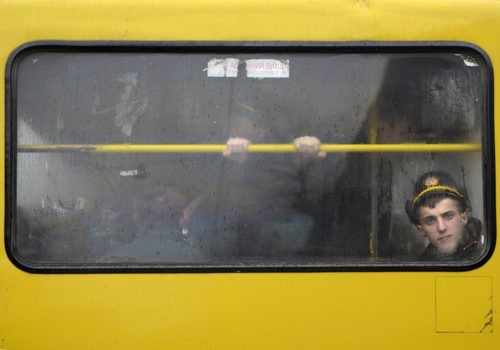Exhibited for the first time in France, this series of photos taken between 2012 and 2014 by Dolph Kessler, a Dutch documentary photographer, tells the story of Lviv, a city with a hard-to- pronounce name, situated in the westernmost part of Ukraine, almost on the Polish border. Forged by a chaotic history, 700,000 inhabitants live there in an ornate and elegant decor that recalls that of Paris or Vienna but with a past as dramatic as Berlin’s. The richness of its political and cultural history makes it a unique city where the population is thriving again after all the post-war upheavals.
Fascinated by the old Soviet-era trolleys, whose fate is to be replaced by small yellow buses – or marshrutkas – Dolph Kessler went to meet their passengers.
We are reminded of Robert Frank’s famous 1955 picture taken in New Orleans, and which figures on the cover of the reissue of The Americans: the passengers of a trolley, whose silhouettes stand out in the darkness, gaze out at the photographer. The vehicle is stopped and the double framing – that of the windows and of the photo itself – turns these individuals into protagonists of a singular story, a miniature society governed by its own laws. Like a movie poster or a travel brochure advertising a far-off land.
We are struck by the same mix of intrusiveness and fiction in Dolph Kessler’s images. The passengers of Lviv’s trolleys or buses are turned into as many groups, families, and clans, whose portraits roll by before our very eyes. White light cuts profiles out of the background as in Flemish painting. The postures, their aloof or intrigued faces, the snow-swept landscapes outside, the intimidating multitude of gazes trained on us, all of this plunges the spectator into a closed world.
At one point, it’s a young soldier in uniform whose face appears in a corner while two unsettling fists firmly grip the bar, as in a muscled interrogation. The window preserves the secret as much as it protects us from the action. The border it offers is ambiguous; the condensation that forms creates blurry zones, giving certain passengers the leisure to observe us without being seen.
Who are these passengers? They don’t seem to be members of any particular group, or family. They are just people coming and going in the city. The only thing they share is living in it. But living where? Lviv? Lvov? Lwow? Leopolis? Lemberg? Have we ever seen a place change names so often? The images that Kessler takes of this Ukrainian city, which he discovered by accident in 2012, barely lift the veil. There are the Orthodox churches in front of which the faithful come to confess on nice days, the abandoned synagogues, the underground tunnels overflowing with old manuscripts attesting to a prosperous and multicultural past. There are the inhabitants who keep black-and- white portraits of a bygone era in their homes, like relics…
This former urban-planner has indeed invited us to an exploration of memory. The city he shows has been spared by globalization, afoot in every other large city in Europe. In addition to an elegant city, we discover a vestige of this post-Soviet Europe. Unusual in that it was never bombed during the Second World War, the décor seems to have remained in a bubble. Now, we hesitate over the nature of the regards trained on us – as though through the glass wall of an aquarium – and the vertigo they produce. Is it us, Western Europeans, who are peering in at these locals, or is it they, through the vision of this photographer from elsewhere, who are asking us what we’ve become on our side of the iron curtain…
















